POSEIDON: A New Hash Function for Zero-Knowledge Proof Systems 学习笔记
Posted mutourend
tags:
篇首语:本文由小常识网(cha138.com)小编为大家整理,主要介绍了POSEIDON: A New Hash Function for Zero-Knowledge Proof Systems 学习笔记相关的知识,希望对你有一定的参考价值。
1. 引言
Grassi等人2019年论文《POSEIDON: A New Hash Function for Zero-Knowledge Proof Systems》。
前序博客有:
相关代码实现有:
- https://github.com/dusk-network/Poseidon252
- https://github.com/shamatar/poseidon_hash
- https://github.com/daira/pasta-hadeshash
- https://github.com/zcash/orchard/blob/main/src/circuit/gadget/poseidon.rs
- https://github.com/lovesh/bulletproofs-r1cs-gadgets/blob/master/src/gadget_poseidon.rs
- https://github.com/shamatar/rescue_hash(Rescue hash)
SNARK、STARK、Bulletproofs(PLONK/RedShift)中,若用于proof of knowledge of a preimage under a certain cryptographic hash function时,都需要消耗大量的计算。
所谓proof of knowledge of a preimage under a certain cryptographic hash function,针对的场景为:
- public info: h , H h,H h,H
- private info: x x x
- 待证明relation: h = H ( x ) h=H(x) h=H(x)
其中 H ( ∗ ) H(*) H(∗) 为hash函数。
若hash函数为POSEIDON,其具有8x fewer constraints per message bit than Pedersen Hash。
POSEIDON hash可:
- 紧凑地以circuit表示
- tailored for various proof systems using specially crafted polynomials,从而进一步提升性能。
借助POSEIDON hash,采用Bulletproofs方案来实现1-out-of-10亿 membership proof with Merkle trees,所需的时间少于1秒。
1.1 不同circuit对比
此处主要考虑2种circuit:
- R1CS(rank-1 quadratic constraints):用于ZK-SNARKs和Bulletproofs中。
- algebraic execution trace (AET) :用于ZK-STARKs和PLONK中。
1)R1CS(rank-1 quadratic constraints):
Bulletproofs 和 ZK-SNARKs 采用R1CS format(rank-1 quadratic constraints)来描述circuit,表示为一组二次多项式:
L
1
(
X
)
⋅
L
2
(
X
)
=
L
3
(
X
)
L_1(X)\\cdot L_2(X)=L_3(X)
L1(X)⋅L2(X)=L3(X)
其中
X
X
X为the tuple of internal and input variables,
L
i
L_i
Li为affine forms,
⋅
\\cdot
⋅为the field multiplication。
R1CS circuit中的加法门和乘法门都是定义在prime field
G
F
(
p
)
GF(p)
GF(p)内。
G
F
(
p
)
GF(p)
GF(p)为the scalar field of an elliptic curve,对应ZK-SNARKs来说,该椭圆曲线通常需pairing-friendly;对于Bulletproofs来说,该椭圆曲线通常仅需为secure curve即可。
R1CS的proof generation complexity与constraints的数量
T
T
T成正比,而constraints的数量
T
T
T通常与乘法门的数量相关。
2)algebraic execution trace (AET):
algebraic execution trace (AET) 将computation 表示为 a set of internal program states related to each other by polynomial equations of degree
d
d
d。该state包含了
w
w
w field elements,并经历
T
T
T transformations。
AET的proof generation与
w
⋅
d
⋅
T
w\\cdot d\\cdot T
w⋅d⋅T 成比例。The number and sparsity of polynomial constraints do not play a major role。
1.2 实现的POSEIDON家族
POSEIDON采用 HADES 设计策略,基于具有
t
t
t cells的substitution-permutation networks,使用了名为partial的rounds,采用了non-linear functions only for part of the state。
POSEIDON中在partial rounds中仅使用了1个S-box,但是在所有其它rounds中使用了full non-linear layers(即
t
t
t个S-box),从而可降低R1CS或AET的开销。
POSEIDON支持80、128、256-bit security:
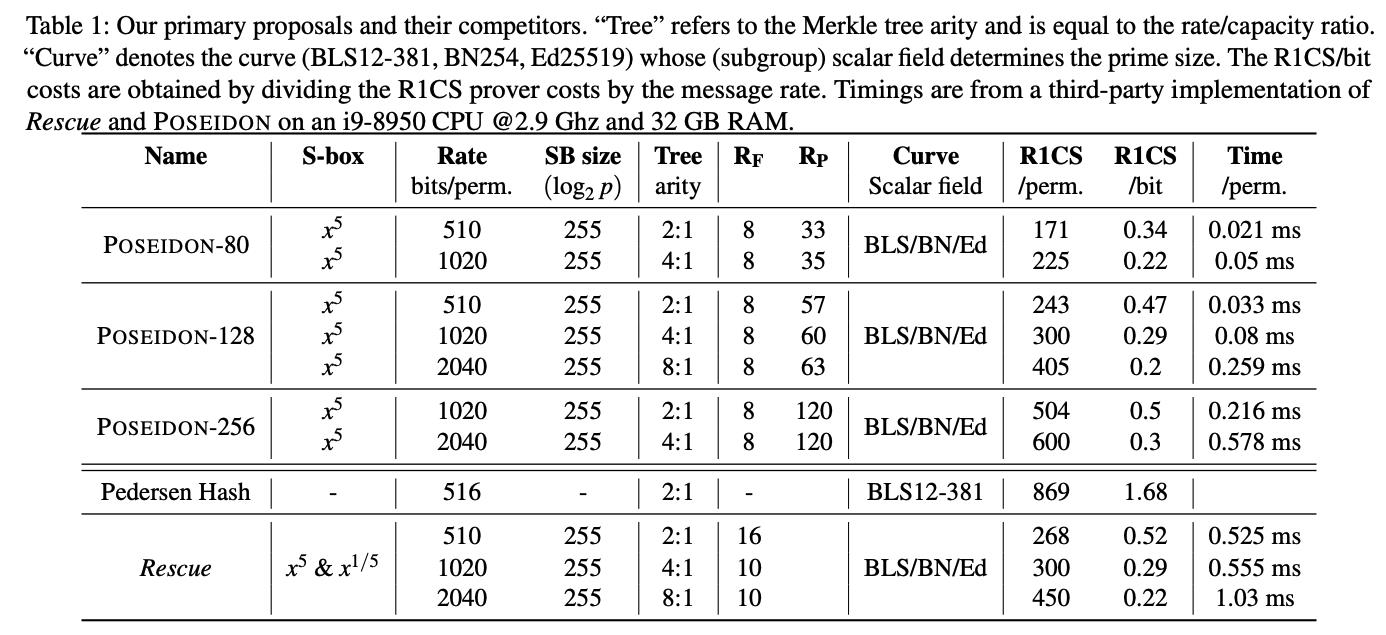
1.3 POSEIDON性能
-
Groth16:
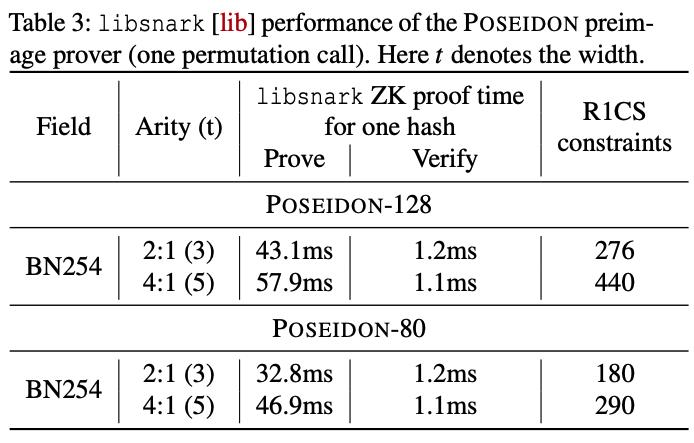
-
R1CS 用于Prove a leaf knowledge in the Merkle tree of 2 30 2^30 230 elements:
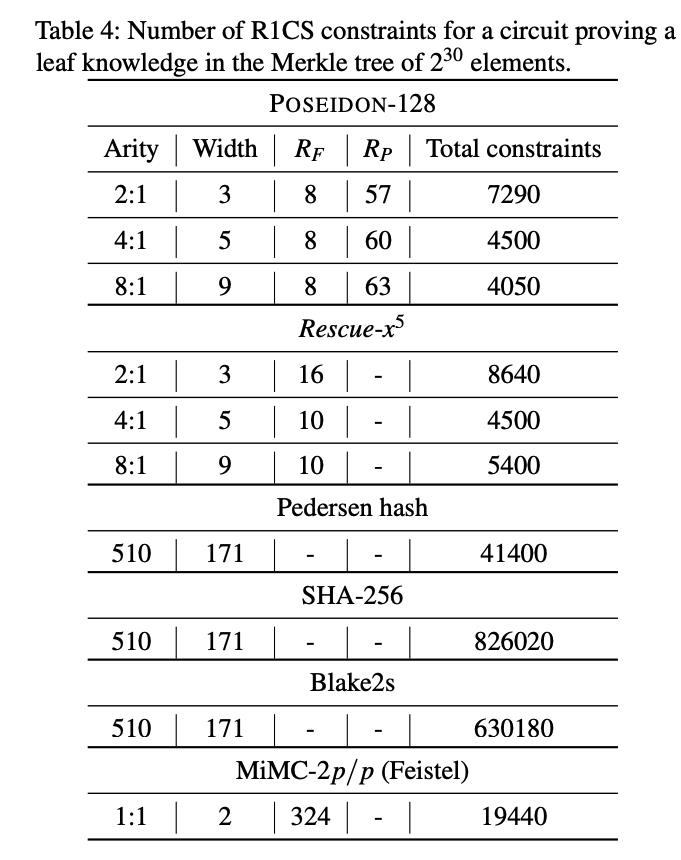
-
Bulletproofs 用于Prove a leaf knowledge in the Merkle tree of 2 30 2^30 230 elements:
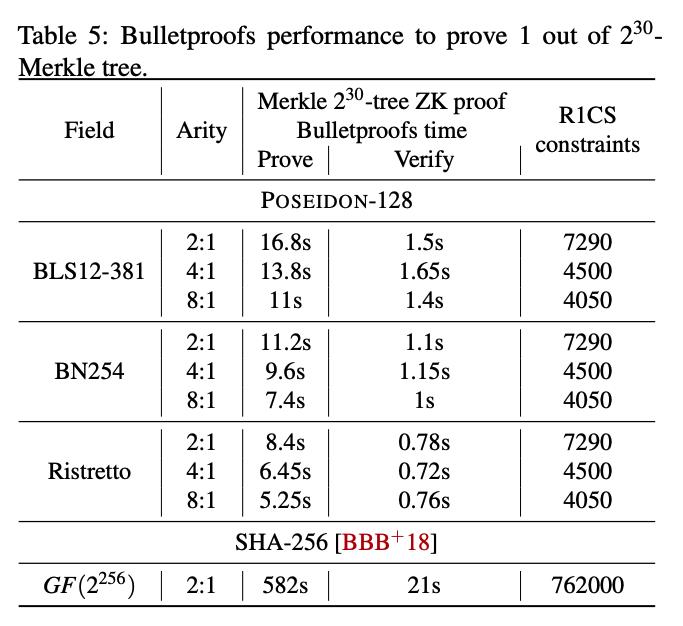
-
PLONK 用于证明1-out-of- 2 n 2^n 2n Merkle tree of arity of 4 4 4:
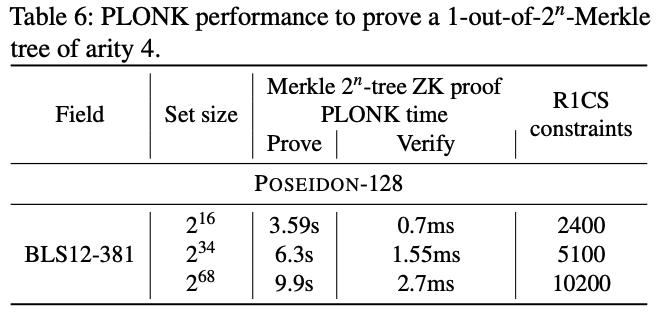
2. Sponge Construction for POSEIDON
Sponge构建与Hades permutation之上,可用于实现:
- encryptiong
- authentication
- hashing
Sponge额外定义了2个参数:
- r r r:为rate。在tree hashing上下文中是指arity。rate定义了吞吐量。
- c c c:capacity。或inner part。capacity则决定了security level。
当将内部的Hades permutation size固定为 N N N bits,则需要在吞吐量和安全性之间做平衡。
以下图为例,用于计算the hash output为
h
1
∣
∣
h
2
h_1||h_2
h1∣∣h2 of the
4
4
4-block message
m
1
∣
∣
m
2
∣
∣
m
3
∣
∣
m
4
m_1||m_2||m_3||m_4
m1∣∣m2∣∣m3∣∣m4,其中
m
i
m_i
mi和
h
i
h_i
hi为
r
r
r-bit values。初始state
I
I
I为全0,即
I
=
0
r
∣
∣
0
c
I=0^r||0^c
I=0r∣∣0c for an
r
r
r-bit rate and a
c
c
c-bit capacity。
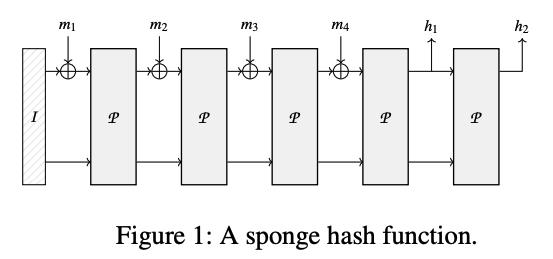
3. POSEIDON hash代码解析
详细参看:

其中messages.chunks(WIDTH - 1) 对应为
m
1
,
m
2
,
m
3
,
m
4
m_1,m_2,m_3,m_4
m1,m2,m3,m4。
state[0]对应为capacity。
/// The `hash` function takes an arbitrary number of Scalars and returns the
/// hash, using the `Hades` ScalarStragegy.
///
/// As the paper definition, the capacity `c` is set to [`WIDTH`], and `r` is
/// set to `c - 1`.
///
/// Considering `r` is set to `c - 1`, the first bit will be the capacity and
/// will have no message addition, and the remainder bits of the permutation
/// will have the corresponding element of the chunk added.
///
/// The last permutation will append `1` to the message as a padding separator
/// value. The padding values will be zeroes. To avoid collision, the padding
/// will imply one additional permutation in case `|m|` is a multiple of `r`.
pub fn sponge_hash(messages: &[BlsScalar]) -> BlsScalar
let mut h = ScalarStrategy::new();
let mut state = [BlsScalar::zero(); WIDTH];
// If exists an `m` such as `m · (WIDTH - 1) == l`, then the last iteration
// index should be `m - 1`.
//
// In other words, if `l` is a multiple of `WIDTH - 1`, then the last
// iteration of the chunk should have an extra appended padding `1`.
let l = messages.len();
let m = l / (WIDTH - 1);
let n = m * (WIDTH - 1);
let last_iteration = if l == n
m.saturating_sub(1)
else
l / (WIDTH - 1)
;
messages
.chunks(WIDTH - 1)
.enumerate()
.for_each(|(i, chunk)|
state[1..].iter_mut().zip(chunk.iter()).for_each(|(s, c)|
*s += c;
);
// Last chunk should have an added `1` followed by zeroes, if there
// is room for such
if i == last_iteration && chunk.len() < WIDTH - 1
state[chunk.len() + 1] += BlsScalar::one();
// If its the last iteration and there is no available room to
// append `1`, then there must be an extra permutation
// for the padding
else if i == last_iteration
h.perm(&mut state);
state[1] += BlsScalar::one();
h.perm(&mut state);
);
state[1]
参考资料
[1] Encoding and Hashing of Long Objects with Poseidon
[2] Dmitry Khovratovich 的hackmd系列中有多个关于Poseidon的笔记
[3] Plonk and Poseidon
[4] Poseidon: ZK-friendly Hashing
以上是关于POSEIDON: A New Hash Function for Zero-Knowledge Proof Systems 学习笔记的主要内容,如果未能解决你的问题,请参考以下文章